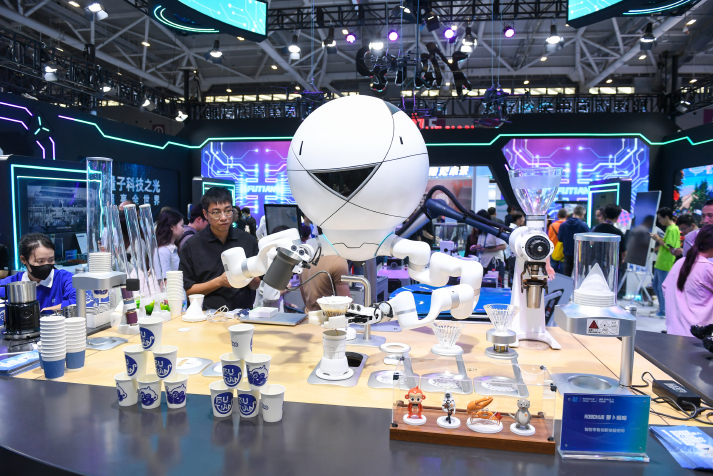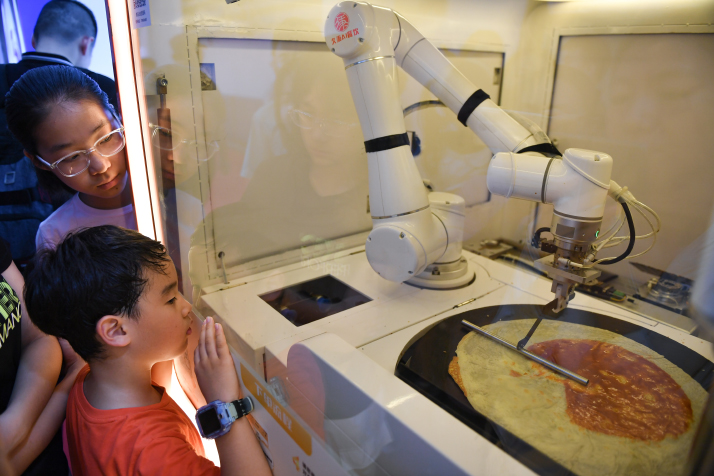| China |
| Sizzling Hot | |
|
|
 A robot makes coffee at the 26th China International Hi-Tech Fair in Shenzhen, Guangdong Province, on November 14 (XINHUA)
The aroma of sizzling spices and savory pork fills the kitchen of a restaurant in Chengdu's Jinjiang District, located in the southwestern Chinese province of Sichuan. But there's no human chef in sight. Instead, a cooking robot powered by artificial intelligence (AI) takes charge, effortlessly whipping up a plate of "fish-flavored shredded pork," demonstrating its culinary prowess. After feeding the ingredients—shredded pork, bamboo shoots and wood-ear mushrooms into a box and a quick click on the "fish-flavored shredded pork" option, the robot goes to work. It swiftly preheats, adds oil and introduces the ingredients in a precise order, stir-frying with practiced ease. In just 63 seconds, the fragrant dish is ready to serve. "It tastes great, and service was really fast. If I hadn't been told, I wouldn't have known a robot made this," a customer shared with newspaper People's Daily. This restaurant is at the forefront of a growing trend. Its kitchen employs five AI robots, each cooking classic Sichuan dishes like twice-cooked pork slices—tender pork belly stir-fried with a medley of vegetables, and Mapo tofu, a dish featuring soft tofu in a rich, spicy and savory sauce. The robots are capable of mastering complex cooking techniques, including frying, stir-frying and even deep-frying. "Cooking robots simulate manual cooking techniques, striving to reproduce the flavor and texture of handmade food," Yu Qinwei, Chairman of Jiubing Robot (Beijing) Co. Ltd., told People's Daily. Across the country, cooking robots are increasingly taking over kitchens, ushering in a new era for the food and beverage industry. Reducing costs Earlier this year, a cook-off drew the industry's attention when a cooking robot from Beijing's Xianglu Technology Co. Ltd. went head-to-head with seasoned human chef Yang Sun. The competitors prepared three classic dishes: stir-fried sea snails with bamboo shoots, stir-fried beef with peppers and stir-fried pork with peppers. The robot performed on par with Yang in terms of color, aroma and flavor. However, the robot outperformed the human chef in speed, completing all three dishes in just three minutes and eight seconds, while Yang took nine minutes and 32 seconds. The AI chef's impressive abilities are powered by sophisticated culinary large AI models. The "Zhurong" model, developed by the food preparation and sharing platform Wan AIChef, doesn't just automate cooking; it also tailors meals to individual users' preferences. To train the AI model, Wan AIChef assembled a team of hundreds of chefs, gathering extensive data using specialized tools such as odor sensors. These sensors capture details like temperature, color changes and aroma variations during the cooking process. AI chefs have gained regulatory approval to enter the market. In a pivotal move, the Haidian District Market Regulation Bureau in Beijing issued the city's first food business license for embodied AI cooking robots to EncoSmart Technology, a Beijing-based robotics and AI firm, in September. Embodied AI refers to the integration of AI into physical entities like robots, allowing them to perceive, learn and respond to their surroundings. The transformative potential of embodied AI has the potential to revolutionize industries such as the food and beverage sector, where it can lead to groundbreaking innovations. Unlike single-task robots that are limited to making pancakes or noodles, embodied AI cooking robots possess the ability to assess ingredients, control cooking times and flavors, and continuously generate new menus through self-learning. Additionally, they can detect and report potential safety hazards in their working environment. "Traditional cooking robots could only follow pre-programmed instructions. If someone interfered with their operation, the robot could potentially cause harm," explained Chen Zhen, founder and CEO of EncoSmart Technology, to newspaper Science and Technology Daily. "However, with embodied AI algorithms, these new robots can assess safety risks, recognize human actions, and make human-like decisions, greatly improving safety." The food and beverage industry is facing intense competition, driving businesses to seek innovative solutions. With rising costs in rent, labor and ingredients, companies are actively looking for ways to reduce expenses and boost efficiency. The adoption of AI chefs is emerging as a promising solution that could revolutionize meal preparation and delivery. Take, for example, the preparation of stir-fried spicy chicken. Manual cooking typically takes eight to 10 minutes, with labor costs ranging from 7 to 13 yuan ($1-1.8). An AI chef, however, can complete the same dish in just 3.5 minutes, with energy costs as low as 0.5 yuan ($0.07). Furthermore, the initial investment and maintenance costs of these AI robots are relatively low, making them an increasingly attractive alternative for businesses of all sizes. According to the 2024 China Food and Beverage Industry Report from the China Hospitality Association, 65.7 percent of surveyed companies have incorporated digitalization into their strategic plans, highlighting the growing acceptance of technology in the sector.  A cooking robot makes a jianbing, a popular Chinese street food often described as a "savory crepe," at the World Robot Conference in Beijing on August 21 (XINHUA)
Despite recent advancements, the overall adoption of digital intelligence in the food and beverage industry remains low, indicating significant potential for growth and refinement. While some robots have entered the market, many are still limited to pre-programmed functions. These robots struggle to adapt to the diverse needs and preferences of individual consumers and lack the ability to self-learn. To lift the quality of services and spur innovation, nine Central Government departments, including the Ministry of Commerce, issued the Guidelines on Promoting High-Quality Development of the Food and Beverage Industry this March. These guidelines encourage the research and application of AI, big data, blockchain technology and smart equipment within the sector, signaling a government-backed push toward a more technologically advanced future for the industry. Human-machine collaboration The considerable potential of AI to transform the food and beverage industry raises an important question: Will AI chefs eventually replace human chefs? Chen, a proponent of automation, argued that many dishes follow strict standard requirements, making them ideal for robotic preparation. AI chefs, according to him, can guarantee consistent quality and flavor, eliminating variations often found in manual cooking. However, cooking enthusiast Luo Jian, speaking to People's Daily, pointed out a key concern: AI-prepared dishes may lack the "wok hei"—the smoky, charred flavor that comes from high-heat cooking in a wok. Luo asserted that the intuitive skill of managing ingredients and heat is developed over years of a chef's experience, a nuanced expertise that machines have yet to fully replicate. Industry experts offer a more balanced perspective, acknowledging that as technology advances, robots can efficiently handle lower-skill tasks, ensuring consistency and reducing human error. However, when it comes to creativity, recipe development and the subtle art of flavor manipulation, human chefs remain irreplaceable. Looking ahead, many industry insiders envision a future of collaboration between humans and machines in the kitchen. On one side, AI and automation can relieve highly skilled chefs from repetitive tasks, allowing them to focus on developing innovative menus and crafting high-end dishes. On the other side, advancements in technologies like machine learning could empower future robots to assist chefs in fine-tuning flavors and enhancing their culinary creations, leading to a new era of gastronomic possibilities. Copyedited by Elsbeth van Paridon Comments to jijing@cicgamericas.com |
|
||||||||||||||||||||||||||||
|
